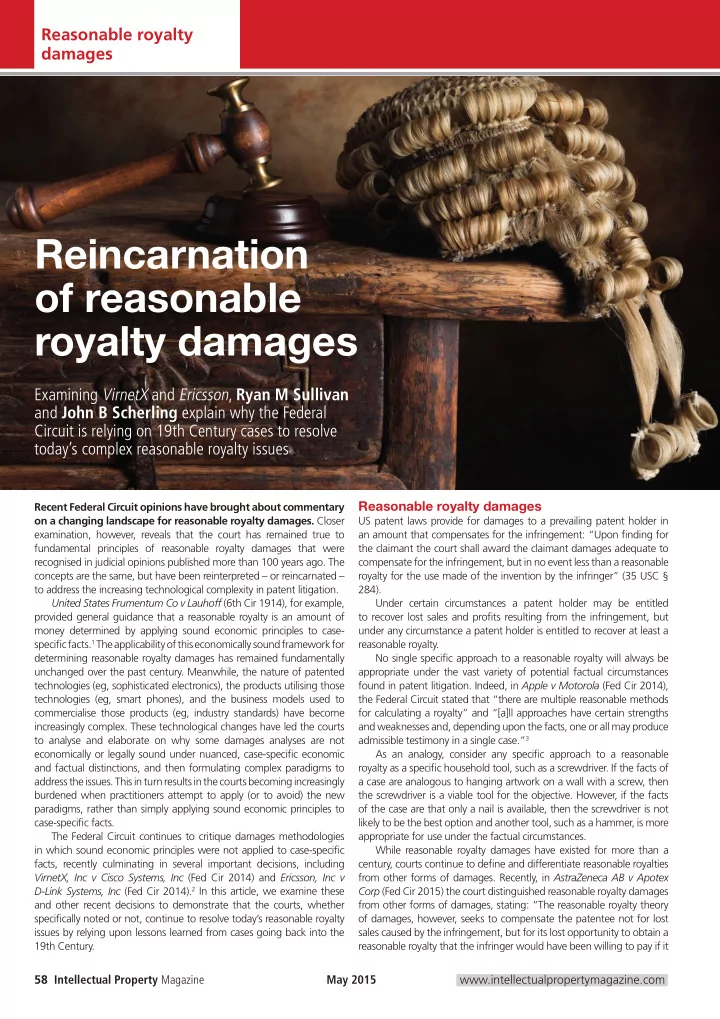

Reasonable royalty damages Reincarnation of reasonable royalty damages Examining VirnetX and Ericsson , Ryan M Sullivan and John B Scherling explain why the Federal Circuit is relying on 19th Century cases to resolve today’s complex reasonable royalty issues Reasonable royalty damages Recent Federal Circuit opinions have brought about commentary on a changing landscape for reasonable royalty damages. Closer US patent laws provide for damages to a prevailing patent holder in examination, however, reveals that the court has remained true to an amount that compensates for the infringement: “Upon finding for fundamental principles of reasonable royalty damages that were the claimant the court shall award the claimant damages adequate to recognised in judicial opinions published more than 100 years ago. The compensate for the infringement, but in no event less than a reasonable concepts are the same, but have been reinterpreted – or reincarnated – royalty for the use made of the invention by the infringer” (35 USC § to address the increasing technological complexity in patent litigation. 284). United States Frumentum Co v Lauhoff (6th Cir 1914), for example, Under certain circumstances a patent holder may be entitled provided general guidance that a reasonable royalty is an amount of to recover lost sales and profits resulting from the infringement, but money determined by applying sound economic principles to case- under any circumstance a patent holder is entitled to recover at least a specific facts. 1 The applicability of this economically sound framework for reasonable royalty. determining reasonable royalty damages has remained fundamentally No single specific approach to a reasonable royalty will always be unchanged over the past century. Meanwhile, the nature of patented appropriate under the vast variety of potential factual circumstances technologies (eg, sophisticated electronics), the products utilising those found in patent litigation. Indeed, in Apple v Motorola (Fed Cir 2014), technologies (eg, smart phones), and the business models used to the Federal Circuit stated that “there are multiple reasonable methods commercialise those products (eg, industry standards) have become for calculating a royalty” and “[a]ll approaches have certain strengths increasingly complex. These technological changes have led the courts and weaknesses and, depending upon the facts, one or all may produce to analyse and elaborate on why some damages analyses are not admissible testimony in a single case.” 3 economically or legally sound under nuanced, case-specific economic As an analogy, consider any specific approach to a reasonable and factual distinctions, and then formulating complex paradigms to royalty as a specific household tool, such as a screwdriver. If the facts of address the issues. This in turn results in the courts becoming increasingly a case are analogous to hanging artwork on a wall with a screw, then burdened when practitioners attempt to apply (or to avoid) the new the screwdriver is a viable tool for the objective. However, if the facts paradigms, rather than simply applying sound economic principles to of the case are that only a nail is available, then the screwdriver is not case-specific facts. likely to be the best option and another tool, such as a hammer, is more The Federal Circuit continues to critique damages methodologies appropriate for use under the factual circumstances. in which sound economic principles were not applied to case-specific While reasonable royalty damages have existed for more than a facts, recently culminating in several important decisions, including century, courts continue to define and differentiate reasonable royalties VirnetX, Inc v Cisco Systems, Inc (Fed Cir 2014) and Ericsson, Inc v from other forms of damages. Recently, in AstraZeneca AB v Apotex D-Link Systems, Inc (Fed Cir 2014). 2 In this article, we examine these Corp (Fed Cir 2015) the court distinguished reasonable royalty damages and other recent decisions to demonstrate that the courts, whether from other forms of damages, stating: “The reasonable royalty theory specifically noted or not, continue to resolve today’s reasonable royalty of damages, however, seeks to compensate the patentee not for lost issues by relying upon lessons learned from cases going back into the sales caused by the infringement, but for its lost opportunity to obtain a 19th Century. reasonable royalty that the infringer would have been willing to pay if it 58 Intellectual Property Magazine May 2015 www.intellectualpropertymagazine.com
Recommend
More recommend